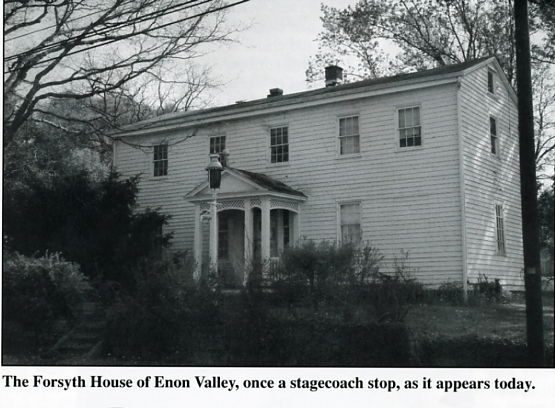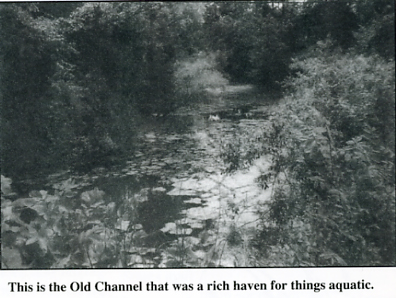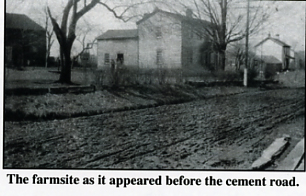
Click Here to Return to Milestones
Editor's Note--Although most of Enon Valley is in Lawrence County today, a small part of it still lies in Beaver County, thus allowing for the inclusion of this story.

With the outbreak of American involvement
in World War I in 1917, my Grandfather Theodore Steinecke II and
Grandmother Mary Winter Steinecke left their roots in the Birmingham
section of the South Side of Pittsburgh, Pa., to live permanently
at their vacation farmsite in the area now known as Old Enon in
Little Beaver Township, Lawrence County, Pa. The homesite is of
wooden structure, perhaps a former tavern, post office and stagecoach
station, was reportedly built in 1779 and is my current residence.
Both my Grandfather and Grandmother were
children of mid-19th Century German immigrants. They were kind
and loving people, with high moral values, and outstanding family
loyalties. Grandfather was a member of the Socialist Labor Party
and was a frequent speaker at local fraternal groups, granges,
Sunday Schools and the like. Both he and Grandmother enjoyed the
company of friends, neighbors and family.
Little Beaver Township is a bit over 19
square miles bordering the Ohio line and about 14 miles north
of the Ohio River. It is mostly farm land, sandy, a bit rocky
and hilly. The population is about 2.000 currently, which includes
Amish families and the people living in the Borough of Enon Valley.
Two streamlets merge about one quarter mile northwest of our home to form the Little Beaver River which flows eastwardly in front of our house about 150 yards away. This creek is not large enough for boating and too wide to jump over in all but a few places. It meanders and soon flows west to the State of Ohio, then south where the stream returns to Pennsylvania and joins the Ohio River at a point where the states of West Virginia, Ohio and Pennsylvania join near Glasgow, Pa.

The Pennsylvania Department of Transportation, while cementing
the mud road from New Castle to points south in 1927 straightened
the road, as well as the local creeks, including parts of the
Little Beaver and it's tributaries, Honey Creek and the North
Fork of the Little Beaver. They dug a new straight channel through
the sine curves of the existing streams. This left a number of
crescent shaped "old channels." Aenon Valley (John 3:23)
is the "Valley of many waters." Several of these old
channels are spring-fed and do not dry up. The excess waters now
run into the new channel. These remaining old channels currently
support catfish, frogs, muskrats and all sorts of creepy, crawley
creatures, including the Snapping Turtle.
My Grandparents hosted several get-togethers
a year. Family, friends and neighbors were often invited on Thanksgiving,
Christmas, New Years, birthdays, graduations, and once a year
in August for a Turtle Soup Party.
In order to have turtle soup, you have to
capture the cold blooded reptiles, which are cousins of snakes,
lizards and alligators. Millions of years ago the turtle preceded
their kin, the dinosaurs, and survived them.
About 75 years ago, there were three men
in the Enon area who were characterized as "turtle hunters."
They were Sid Cook, Fritz Zeh and Chuck Albright. They each had
a large barrel or enclosed pond where they stored and cleansed
the future soup.
There were at that time several methods
used to capture these Mossbacks, one is with a hook and line baited
with a fish or Sparrow, and attached to a board or jug anchored
in the water. Sometimes they can be caught on land during the
egg laying times of May or June. The most popular way was for
the hunter to wade in the water and watch the shell-backs as they
swim toward the bank to hide. The frightened critter goes in head
first. The hunter reaches in, feels his way around the shell,
and pulls it out. Snappers vary in size, most of them in this
area being 12 to 16 inches wide. The hunter then throws the catch
up on the bank to his helper, usually a youngster, who then deposits
the bewildered Snapper in a burlap bag.
A neighbor, Mr. Nevin Stuart, told me the
other day he served as Chuck Albright's assistant several times.
Chuck, who was part Kuskuski Native American, charged around the
water noisily unlike the images boys have of stealthy, stalking
warriors. Chuck while groping around the banks would throw, not
only turtles, but snakes, frogs, and water dogs at his assistant,
and had much glee when he made contact.
Chuck, who was an Army veteran of World
War I lived with his parents, an older brother and two sisters
at the family general farm about a quarter mile north of us. Chuck
was a stonemason, had large hands, and was in the first years
of over a three-decade courtship of Millie Stauffer, the daughter
of a dairy farmer who lived a quarter mile south of us. Chuck
supplied the turtles for the feast, keeping the prey in a huge
rain barrel located under the barn downspout of his future father-in-law,
Bob Stauffer. Even as a child I questioned the wisdom of housing
a turtle in a barrel of water in the summer, while being fed raw
meat. Malodorous is the word for it. I must say I never found
the soup distasteful.
Chuck and Millie, his fiancée, dressed
the turtles for the soup pot in the outdoors around a 25-gallon
wood fired kettle almost full of boiling water. They placed the
doomed beasts, that seemed to realize their fate, on a table made
of wood horses and planks, the axes and knives carefully placed.
The heads snapped aggressively and speedily at times; often the
beasts pulled their heads and feet under their shells for protection.
Usually the heads had to be pulled out by a pair of pliers, then
the ax used. These reptiles were long dying -- no wonder they
survived the dinosaurs. Chuck always wore gloves when handling
live Snappers. He especially and wisely wore gloves when reaching
in after them under the water that gave him the opportunity to
pull out should a finger get caught. It must have worked because
at his funeral in 1965, I observed he still had all fingers and
both thumbs.
The fossil held by the tail is bled and
then dipped into the scalding water for a minute or two. Then
cleaned free of moss and algae, turned upside down, the bottom
shell called the star is usually removed. Seven hunks of savory
meat can then be cut out. The turtle is unusual in that its tail,
neck and four legs and shoulders are hidden inside its body. The
top shell is the back bone, the ribs are attached to the shell.
Under the ribs is a delicacy in the form of a finger size extra
special treat. The flesh is carefully cleaned, cut into about
one half inch cubes, then delivered to the cooks indoors. The
neck meat is dark, the morsal is a bit lighter.
Turtle soup is vegetable soup using turtle
meat instead of beef. Grandmother had a large four-burner gas
stove in her kitchen and a two-burner hot plate in the cellar.
These were the days of the great depression,
the time of bank failures, and other financial crises of unprecedented
severity.
This area, at that time, was populated by people mostly suffering from "hard times." Most citizens were small general substance type farmers; others included retirees, and many unemployed or partially employed miners and railroad workers, not to mention shopkeepers and a smattering of steel workers. In order to "keep the wolf from the door" and food on the table, people augmented their pantries in various ways. Some became part time hunters, many housewives became expert at cooking edible wild plants, some poached game and others resorted to fishing with dynamite. One guest operated a still, young men gathered honey from wild bees living in hollow trees, a suspected cattle rustler was not present at the gathering, some Klan members were. The guests came with their contributions to the feast. Tomatoes and early potatoes were prevalent, not to mention other vegetables, rice, noodles, carrots and beans. One lady brought bread and used Grandmother's oven - her own gas being shut off by the utility company. Some brought firewood for the outside kettle. Mrs. Stauffer brought a large wooden bowl of butter.

Grandmother and Grandfather's house was unique in many respects.
I believe they had the only bathtub and flush commode in the township.
Water was gravity piped from a nearby hillside to the barn and
upstairs bathroom. The well in the front yard, by unique piping,
allowed water to be hand-pumped while in the kitchen. Electricity
had not yet come to the township.
Screen doors were a rarity. The barn was
100 feet from the house and the outhouse was clustered in lilac
bushes near the back door. Sometimes flies were a problem. Some
discussed the merits of Grandfather's central heating.
While the soup was simmering, people chatted, youngsters played.
Grandfather had a crystal set type radio that was located in a
dark cupboard under the stairs. We children took turns at the
earphones listening to station KDKA in Pittsburgh and WTAN in
Cleveland.
Toward dusk dinner was served. Soup, bread,
coffee and German Kuchen were the staples. People ate at tables
inside and out on the front and back steps. Grandfather lit a
fidibus and ignited the gas mantels that brightened the night
with a warm pleasant glow.
Conversation at dinner was quiet and cheerful.
The topics were the drought, hard times, crops and taxes. Most
were neatly dressed, all seemed to observe the social graces to
the point of being almost formal. No one seemed to have cash.
Some farmers paid their taxes by working on the roadways, using
their teams to mow and grade the mud township roads.
Housewives during trying times sewed and
mended hand-me-down clothes, using special cloth of sugar and
flour sacks. That material was dyed and easily washed out. The
suppliers offered underwear patterns. the Quaker Oats Company
inserted china inside the boxes of their product. Almost all Enon
children went barefoot in the summer and wore their one pair of
shoes to church and special occasions. A friend told me the other
day that he, during that period, had only one pair of trousers
-- a situation that kept him inside the house on washdays. One
of my older cousins married a barber who lost his job; undaunted
he became a "back-porch barber." His patrons paid him
in various ways. Often he even got a bit of money. He trapped
fur-bearing animals during the winter. His wife and two children
were not in need. It was considered a disgrace for anyone to "take
relief."
Women canned almost everything they could
get their hands on. Many had evaporators and dried fruits and
vegetables. Frugal people would can fruits without sugar. "Company"
sugared fruits were not for normal family consumption, but saved
for guests.
At the feed mill in nearby Bessemer, Pa.,
Elsie and I met the owner, Wayne "Bigfoot" Anderson.
Mr. Anderson is a student of turtle lore. He has two ponds in
the back of the establishment that serve as a zoo during the summer
months; he lectures at children's events, has photos and various
turtle artifacts. His method of catching turtles, not restricted
by the fish and game laws, was to find them in the winter hibernating
in the mud under the clear ice in shallow ponds. Chopping through
the ice with a machete, he grabs them before they wake up. Mr.
Anderson said while employing the old way one sometimes grabbed
the turtle the wrong way, or latched on to a muskrat instead.
Chuck Albright is long gone and the turtle
culture has changed, but lingers on. Locally the volunteer fire
department of Petersburg, Ohio, has a turtle soup dinner on the
third Saturday of August. The Springfield Grille, a few miles
northwest of us in Boardman, Ohio, serves turtle soup regularly.
It is spicy, and I didn't think it was too bad -- certainly not
like Grandmother used to make. Maybe I missed the tastes of the
old channels and Bob Stauffer's' rain barrel.
I believe the country people during hard
times fared better than the town folks. Our rustic life of the
past has given way to rural electrification, cement highways and
the automobile.
The Little Beaver River flows on and recently
Elsie and I bought a bit a land on which it flows through.
July 2003